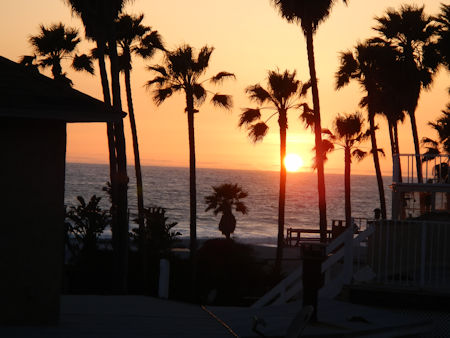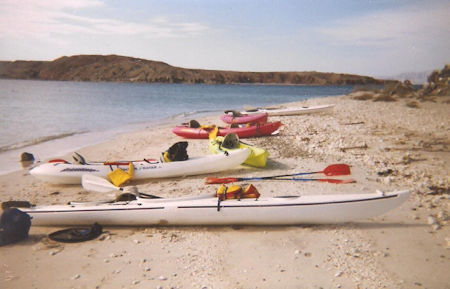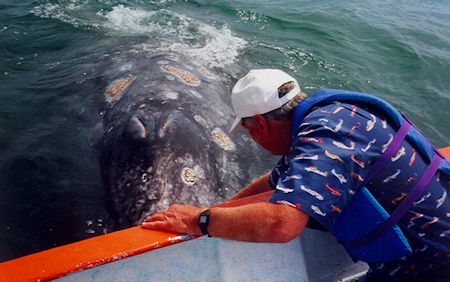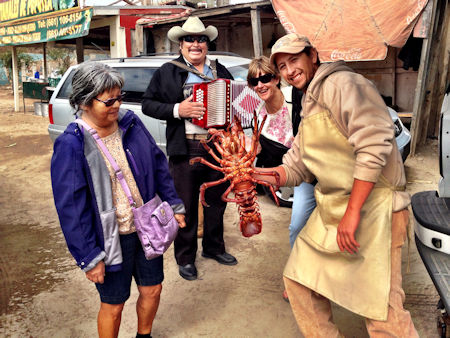 |  |
By Greg Niemann

An acquaintance who knew I was a Baja buff once commented that she and her husband had gone down to Baja California the previous summer. “We had a great time,” she admitted, and then added, “but it sure was nice to get back across the border to the good old U.S. of A.”
Obviously that couple was not afflicted with Baja Fever. To those who have this chronic disease, the comfort is crossing the border going south. I will concede that it is nice getting the car into high gear on the wide, multi-lane U.S. freeway after leaving the border congestion, but I am saddened each time I cross north, not relieved.
I know I’m back in a land where precious minutes and seconds are all-important, where material goods and status mean more than character and family and friends. Where I know I’ll be busy just managing my daily affairs.
Going south has always been great therapy for me, especially before I retired. After a busy week in the business world I would cross the border and immediately start slowing down. My heart would start beating slower in Baja. My attitude began mellowing. Within a day my self-regulatory watch would be put in a drawer until we had to leave. It’s easy to lose track of time in Baja, even lose track of days, because you’re not compelled to count.
The slower pace of Baja offers a sense of timelessness, and those who can forsake the commuter traffic, or jump off the corporate merry-go-round long enough to enjoy it rarely regret it. The wife of one manager we took to our Baja house marveled for years afterward that she had never seen her Type-A husband as relaxed as he was that weekend.
John Steinbeck described the feeling well in his Log From The Sea of Cortez when he acknowledged, “The matters of great importance we had left were not important….Our pace had slowed greatly: the hundred thousand small reactions of our daily world were reduced to very few.”
Baja is unique
Baja is unique – even to the rest of Mexico. There are more American tourists and expats, and a greater influence by them especially in the border region where the dollar is widely used and English is widely spoken.

There is more desolation in Baja. And there is a greater feeling of remoteness, of being apart from mainland Mexico.
Early tribes of those who crossed from Asia to populate the Americas had lived in Baja California and left their legacy in art work on the walls of obscure caves in distant mountain valleys. The confines and harshness of the narrow peninsula had entrapped them and they and their descendants eked out livings in a difficult land.
Then in the 1600s Europeans arrived on the peninsula, some seeking gold and land to conquer, while others sought heathens they could convert to their religion. While the gold mostly eluded them, the padres found plenty of indigenous habitants as they established a chain of missions from the tip of Baja all the way up to northern California’s San Francisco area.
From 1697, when the first permanent settlement in the Californias was established at Loreto, the next 100 years saw Spanish padres and soldiers conquering and taming the barren and sparsely settled peninsula.
After Mexico won its independence from Spain in 1821, Baja California remained a remote Mexican territory. America tried several times to wrest the peninsula form Mexico even requesting it as one of the spoils of the Mexican/American war. However, Mexico remained adamant and never yielded ownership of the Baja peninsula.
By the late 1800s numerous groups, including English, French and Russians, established small colonies in Baja. Several fortune seekers and renegade Americans also tried to inhabit and/or take over Baja.
The hostile takeover attempts all failed and for that the Baja buff is lucky. Then again, would a different ownership have developed the Baja peninsula any sooner? Probably not. Only recently has rapid progress made any headway.
Max Miller, in his 1943 book Land Where Time Stands Still, noted, “Progress is a debatable subject; but certainly material progress has come slowly and in small measure to Lower (Baja) California. The contrast between its primitiveness and the glittering man-made works of California is sudden and sharp. One is thrown into the past.”
Tourist dollar fuels economy

Today the tourist dollar has created a wealth not imagined by the Mexicans and early settlers and fortune seekers. The growth, especially in the extreme north and south, spearheaded by American and Canadian tourist dollars has made the two peninsular states among the wealthiest per capita of Mexico’s 31 states.
Snowbirds from not only Canada, but Washington, Oregon, and other northern U.S. states have been busy, especially in the last 15 years or so, establishing winter homes in places like Loreto, the East Cape area, and the once small village of Todos Santos.
Todos Santos is now a quick jaunt from either La Paz or the Los Cabos region via newly widened paved roads. That town has seemingly tripled in size every time I’ve seen it. It’s hard for me to believe that in the mid-1970s the rough dirt road from Cabo San Lucas was hard to follow as it was sandy and went through private ranches. And once we arrived in the old sugar-cane town there were only two small inns and a couple of rustic thatch-roofed, dirt floor restaurants.
Baja is one of earth’s last outposts, certainly the only one accessible to so many people. It abuts directly against the affluent and most populous state of the most influential country on this planet. Nowhere else in the world is there such a collision of cultures, values, and lifestyles.
Today more than fifty million people legally cross between San Diego and Tijuana (2017) annually, making the San Ysidro border crossing the busiest international border in the world. That’s about one million people a week!
Being right next door to California, those who cross in either direction whittle away at the differences between the two countries. The Mexicans learn our way of life and we are foolish if we in turn cannot learn from theirs. We have much to gain.
For decades visitors to Baja California have noted the graciousness, friendliness, and helpfulness of their hosts.

In his 1948 book The Land of Shorter Shadows, famous mystery author Erle Stanley Gardner commented, “Baja is a most interesting territory, and it is a friendly territory. Many of the people there don’t have the individual wealth that we have in the United States. But they do have the dignity of men who are making an honorable living, who are close to nature and who have priceless integrity of character. Their poverty is only as to material luxuries….I hope to go back there next year for a longer stay.”
What is Baja Fever?
Once past the busy border region, the peninsula still provides adventure and excitement, and Gardner ended up penning eight books about his Baja explorations. Baja is truly the last outpost. There’s still enough to see and enjoy for future visitors to also get afflicted with what I call Baja Fever.
Baja Fever means different things to different people. To some it’s petting the friendly whales, or catching that big marlin, or riding horses on the beach, or kayaking in the idyllic Sea of Cortez. To some it’s the world-class off-roading, or windsurfing, or golfing, or shopping, or surfing, or looking for a second home.
To some it’s laying poolside in a resort awaiting another coco-loco. To some it’s being surrounded by a mariachi group with trumpets challenging the acoustics of a small cantina. To many it’s the cuisine from succulent lobster to those inimitable street tacos.
To some it’s bouncing down a dirt road to discover what’s around that next bend, perhaps a broad sandy beach, or an old mine, or a small rancho with friendly people.
Baja is what you make it. Baja Fever begins with an itch, an internal gnawing. It comes when you need an adventure, or to wind down – and you realize it.
Baja Fever is infectious when you know that you have to get down there again – and soon! That’s when you get your fix. That’s when you seek the only known antidote – you go!
You know you are truly afflicted when you note a sadness upon leaving Baja, not relief. You know you’ll soon again catch Baja Fever, and you’ll return.

About Greg
Greg Niemann, a long-time Baja writer, is the author of Baja Fever, Baja Legends, Palm Springs Legends, Las Vegas Legends, and Big Brown: The Untold Story of UPS. Visit www.gregniemann.com.

This was our first trip to Mexico, It was so easy to get our insurance from Baja Bound. Thank you...

Easy and fast in less than 10 minutes you could have insurance for Mexico. I have used them for...

Easy to understand and great customer service. Emailed Michelle with some concerns I had about a...